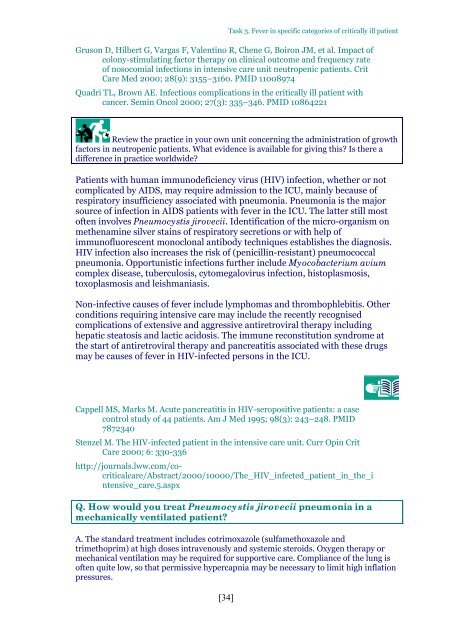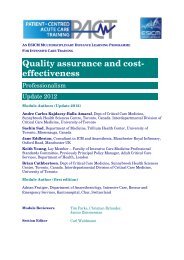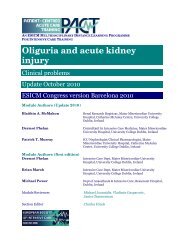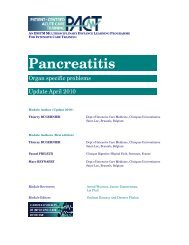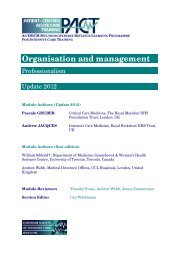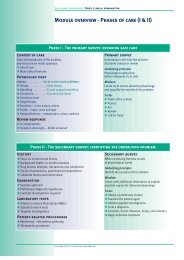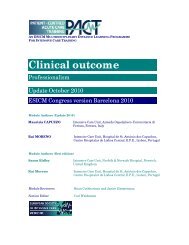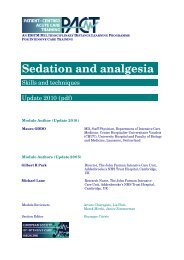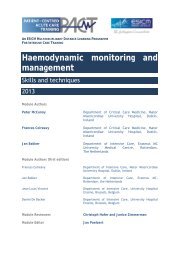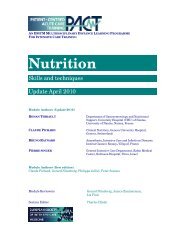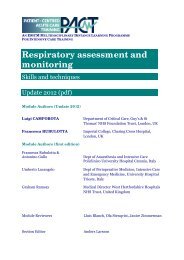Pyrexia - PACT - ESICM
Pyrexia - PACT - ESICM
Pyrexia - PACT - ESICM
You also want an ePaper? Increase the reach of your titles
YUMPU automatically turns print PDFs into web optimized ePapers that Google loves.
Task 3. Fever in specific categories of critically ill patient<br />
Gruson D, Hilbert G, Vargas F, Valentino R, Chene G, Boiron JM, et al. Impact of<br />
colony-stimulating factor therapy on clinical outcome and frequency rate<br />
of nosocomial infections in intensive care unit neutropenic patients. Crit<br />
Care Med 2000; 28(9): 3155–3160. PMID 11008974<br />
Quadri TL, Brown AE. Infectious complications in the critically ill patient with<br />
cancer. Semin Oncol 2000; 27(3): 335–346. PMID 10864221<br />
Review the practice in your own unit concerning the administration of growth<br />
factors in neutropenic patients. What evidence is available for giving this Is there a<br />
difference in practice worldwide<br />
Patients with human immunodeficiency virus (HIV) infection, whether or not<br />
complicated by AIDS, may require admission to the ICU, mainly because of<br />
respiratory insufficiency associated with pneumonia. Pneumonia is the major<br />
source of infection in AIDS patients with fever in the ICU. The latter still most<br />
often involves Pneumocystis jirovecii. Identification of the micro-organism on<br />
methenamine silver stains of respiratory secretions or with help of<br />
immunofluorescent monoclonal antibody techniques establishes the diagnosis.<br />
HIV infection also increases the risk of (penicillin-resistant) pneumococcal<br />
pneumonia. Opportunistic infections further include Myocobacterium avium<br />
complex disease, tuberculosis, cytomegalovirus infection, histoplasmosis,<br />
toxoplasmosis and leishmaniasis.<br />
Non-infective causes of fever include lymphomas and thrombophlebitis. Other<br />
conditions requiring intensive care may include the recently recognised<br />
complications of extensive and aggressive antiretroviral therapy including<br />
hepatic steatosis and lactic acidosis. The immune reconstitution syndrome at<br />
the start of antiretroviral therapy and pancreatitis associated with these drugs<br />
may be causes of fever in HIV-infected persons in the ICU.<br />
Cappell MS, Marks M. Acute pancreatitis in HIV-seropositive patients: a case<br />
control study of 44 patients. Am J Med 1995; 98(3): 243–248. PMID<br />
7872340<br />
Stenzel M. The HIV-infected patient in the intensive care unit. Curr Opin Crit<br />
Care 2000; 6: 330-336<br />
http://journals.lww.com/cocriticalcare/Abstract/2000/10000/The_HIV_infected_patient_in_the_i<br />
ntensive_care.5.aspx<br />
Q. How would you treat Pneumocystis jirovecii pneumonia in a<br />
mechanically ventilated patient<br />
A. The standard treatment includes cotrimoxazole (sulfamethoxazole and<br />
trimethoprim) at high doses intravenously and systemic steroids. Oxygen therapy or<br />
mechanical ventilation may be required for supportive care. Compliance of the lung is<br />
often quite low, so that permissive hypercapnia may be necessary to limit high inflation<br />
pressures.<br />
[34]


